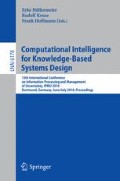Abstract
The paper offers a parallel between two approaches to conceptual clustering, namely formal concept analysis (augmented with the introduction of new operators) and bipartite graph analysis. It is shown that a formal concept (as defined in formal concept analysis) corresponds to the idea of a maximal bi-clique, while a “conceptual world” (defined through a Galois connection associated of the new operators) is a disconnected sub-graph in a bipartite graph. The parallel between formal concept analysis and bipartite graph analysis is further exploited by considering “approximation” methods on both sides. It leads to suggests new ideas for providing simplified views of datasets.
Access this chapter
Tax calculation will be finalised at checkout
Purchases are for personal use only
Preview
Unable to display preview. Download preview PDF.
References
Albert, R., Barabási, A.: Statistical mechanics of complex networks (2001)
Barabási, A., Albert, R.: Emergence of scaling in random networks. Science 286(5439), 509–512 (1999)
Barber, M.J.: Modularity and community detection in bipartite networks. Physical Review E (Statistical, Nonlinear, and Soft Matter Physics) 76(6) (December 2007)
Belohlavek, R.: Fuzzy Relational Systems: Foundations and Principles. Kluwer Academic Publishers, Dordrecht (2002)
Delvenne, J.-C., Yaliraki, S.N., Barahona, M.: Stability of graph communities across time scales. 0812.1811 (December 2008)
Djouadi, Y., Dubois, D., Prade, H.: Differentes extensions floues de l’analyse formelle de concepts. In: Actes Rencontres sur la Logique Floue et ses Applications (LFA’09), Annecy (November 2009)
Djouadi, Y., Dubois, D., Prade, H.: On the possible meanings of degrees when making formal concept analysis fuzzy. In: Eurofuse workshop Preference modelling and decision analysis, Pampelune, pp. 253–258 (2009)
Dubois, D., Dupin de Saint-Cyr, F., Prade, H.: A possibility theoretic view of formal concept analysis. Fundamenta Informaticae 75(1), 195–213 (2007)
Dubois, D., Prade, H.: Possibility theory and formal concept analysis in information systems. In: Proc. 13th International Fuzzy Systems Association World Congress IFSA-EUSFLAT 2009, Lisbon (July 2009)
Fortunato, S.: Community detection in graphs. Physics Reports 486(3-5) (2010)
Ganter, B., Stumme, G., Wille, R.: Formal Concept Analysis: Foundations and Applications. Springer, Heidelberg (2005)
Ganter, B., Wille, R.: Formal Concept Analysis. Springer, Heidelberg (1999)
Gaume, B.: Balades aléatoires dans les petits mondes lexicaux. I3 Information Interaction Intelligence 4(2) (2004)
Gaume, B., Mathieu, F.: PageRank induced topology for real-world networks. Complex Systems (to appear)
Latapy, M., Magnien, C., Del Vecchio, N.: Basic notions for the analysis of large two-mode networks. Social Networks 30(1), 31–48 (2008)
Lehmann, S., Schwartz, M., Hansen, L.K.: Biclique communities. Physical Review E (Statistical, Nonlinear, and Soft Matter Physics) 78(1) (2008)
Newman, M.E.J.: The structure and function of complex networks. SIAM Review 45, 167–256 (2003)
Okubo, Y., Haraguchi, M.: Finding Top-N pseudo formal concepts with core intents. In: Proceedings of the 6th International Conference on Machine Learning and Data Mining in Pattern Recognition, Leipzig, Germany, pp. 479–493 (2009)
Pasquier, N., Bastide, Y., Taouil, R., Lakhal, L.: Efficient mining of association rules using closed itemset lattices. Information Systems 24(1), 25–46 (1999)
Pons, P., Latapy, M.: Computing communities in large networks using random walks (long version). Journal of Graph Algorithms and Applications (JGAA) 10(2), 191–218 (2006)
Porter, M., Onnela, J.P., Mucha, P.J.: J Mucha. Communities in networks. Notices of the American Mathematical Society 56(9), 1082–1097 (2009)
Rosvall, M., Bergstrom, C.T.: Maps of random walks on complex networks reveal community structure. Proceedings of the National Academy of Sciences 105(4), 1118–1123 (2008)
Roth, C., Bourgine, P.: Epistemic communities: Description and hierarchic categorization. Mathematical Population Studies 12, 107–130 (2005)
Schaeffer, S.E.: Graph clustering. Computer Science Review 1(1), 27–64 (2007)
Watts, D., Strogatz, S.: Collective dynamics of’small-world’ networks. Nature 393, 440–442 (1998)
Author information
Authors and Affiliations
Editor information
Editors and Affiliations
Rights and permissions
Copyright information
© 2010 Springer-Verlag Berlin Heidelberg
About this paper
Cite this paper
Gaume, B., Navarro, E., Prade, H. (2010). A Parallel between Extended Formal Concept Analysis and Bipartite Graphs Analysis. In: Hüllermeier, E., Kruse, R., Hoffmann, F. (eds) Computational Intelligence for Knowledge-Based Systems Design. IPMU 2010. Lecture Notes in Computer Science(), vol 6178. Springer, Berlin, Heidelberg. https://doi.org/10.1007/978-3-642-14049-5_28
Download citation
DOI: https://doi.org/10.1007/978-3-642-14049-5_28
Publisher Name: Springer, Berlin, Heidelberg
Print ISBN: 978-3-642-14048-8
Online ISBN: 978-3-642-14049-5
eBook Packages: Computer ScienceComputer Science (R0)

